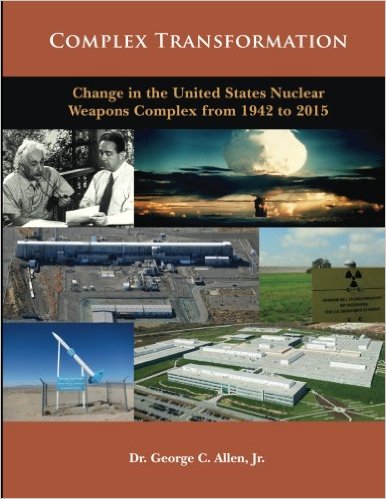Dr. George Allen’s Complex Transformation is a nuclear insider’s take on the constantly evolving United States’ Nuclear Weapons Complex. The book covers an extensive collection of historical nuclear sites across the country. Allen, who received a B.S., M.S., and Ph.D. from MIT in nuclear engineering, spent 27 years at the Sandia National Laboratories before working for the National Nuclear Security Administration (NNSA).
After his retirement in 2011, Allen undertook the ambitious project to travel throughout the United States and visit hundreds of nuclear sites, past and present. While more historical sites are being recognized and preserved, Allen points out, “Many post-Manhattan Project locations are merely viewed as embarrassing environmental legacies to be cleaned, recycled, or abandoned, and then forgotten.” Allen leaves no site forgotten, providing explanation, chronology, and wonderful photographs throughout, including many he took himself.
Allen spends his first chapter giving some historical context for the nuclear age. He then goes through each decade from the 1940s to the 2010s, exploring the transformation of the Nuclear Weapons Complex over the 75 years since its inception. The rest of the book covers sites across the United States. As Allen explains, there were simply too many to cover them all, so he chose sites that primarily contributed to the Manhattan Engineer District, the Atomic Energy Commission, the Energy Research and Development Administration, the U.S. Department of Energy (DOE), and the NNSA.
The sites explored include leadership centers, research centers, and locations for uranium and plutonium production and storage. Other sites include places where secondary materials and non-nuclear components were produced, weapons assembly locations, test sites, and waste disposition sites. While some areas are already famous, such as Los Alamos, Oak Ridge, and Hanford, others are not widely known and are given deserved attention. Many photographs show inconspicuous sites: one would never guess the historical and in some cases continued importance that they bear. Allen furthermore organizes each chapter chronologically so readers can see the continued evolution and transformation of the Nuclear Weapons Complex.
Complex Transformation is extensive and detailed, but easy to understand and meticulously organized. Because Allen received assistance from the DOE, the book includes much information that would be otherwise inaccessible to the public. It is a valuable resource for the continued study and interpretation of the nuclear age.
The book can be purchased on Amazon.





